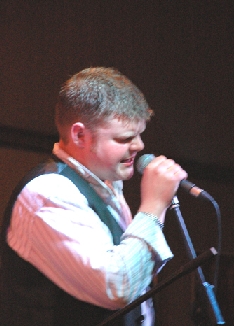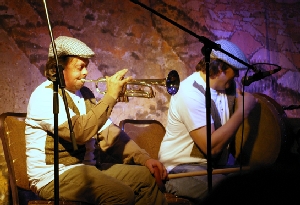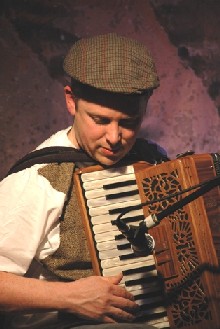
Rattle the Boards @ FolkWorld: FW #12, #36, #36
St. Patrick was a Gentleman
FolkWorld Issue 36 07/2008; Article by Sean Laffey
Rattle in the Parish
Rattle the Boards' The Parish Platform
When we meet up on a windy night in March, the weather is so bad that the Gardaí are advising that only necessary journeys are to be made. I’ve a deadline to meet and a little matter of the Cashel St. Patrick’s Festival to organise, in the words of Elvis Presley it’s now or never, there is no other option. -- Seán Laffey steps it out lively with Pat Ryan and Benny McCarthy of Rattle the Boards.
Home work first, a quick browse of the net to secure a thumbnail history. Unfortunately I hit the band’s biog on the Junction O7 Festival web site. It tells us that the lads first met in 1962. A look at their new album “The Parish Platform” might have you believing that.

Rattle the Boards @ FolkWorld: FW #12, #36, #36 St. Patrick was a Gentleman |
At the allotted time I drive into a space right outside the front door of Lonergan’s and parking beside me in a green Renault van is Benny McCarthy. The last time we passed in traffic he’d been in a Blue BMW, so why the change? Well it’s all to do with that maturity thing, two children and a recording studio (Doon Productions), the need to carry a bit of gear for the band and the French vehicle can do stuff the German wagon just wasn’t designed for (maybe a matter too of a patriotic Breton wife?). Benny tells me that due to the bad weather it will just be himself and Pat Ryan for the interview tonight. Guitarist John Nugent and singer John T Egan won’t be with us, the wind is keeping them at home and one of them is battening down machinery, unlike some bands, Rattle The Boards have day jobs.
Inside the pub, Benny takes me to the platform at the side of the bar, “Here’s where it all started” he tells me and I playfully answer, “that was back in 1962 wasn’t it?” Smiles all round, he’s seen the web site and there’s great humour to be had in the Wiki-fact that the band formed 12 years before Benny was born.
Very soon Pat Ryan joins us, he’s the fiddler and banjo player with Rattle the Boards, a tall man in his mid fifties with a youthful complexion, a great head of black hair and a wicked twinkle in his eye. We settle down with a few coffees and chat away, nearly every sentence has a joke in it and there’s a surfeit of laughter as we pick or way through the band’s history.
There first album was released in 1998, the follow up is ten years on, that’s Martin Hayes productivity “Well we thought we’d give Paddy Moloney a chance to earn a few bob first” Pat says. A fond reference to the Chieftains puts into comic contrast the diversity of ambitions in traditional music.
 Whilst the Chieftains have hobnobbed with Rock and Roll Royalty, Rattle the Boards have rarely gone abroad, having only made their first appearance in America as recently as last September. How did that go? “ We loved it and the audiences did too, we are hopeful of a return visit soon” says Pat. Benny adds that they already have an agent in Canada.
Whilst the Chieftains have hobnobbed with Rock and Roll Royalty, Rattle the Boards have rarely gone abroad, having only made their first appearance in America as recently as last September. How did that go? “ We loved it and the audiences did too, we are hopeful of a return visit soon” says Pat. Benny adds that they already have an agent in Canada.
I tell them I can detect a regional accent in their playing. “We don’t set out to play in any set style, we don’t experiment too much, jazz is beyond us,” laughs Benny “ but we play session music we like and are happy and relaxed with”. There’s a huge dollop of fun in the recording, that remind me of the Flanagan Brother’s sides that were cut in America in the 1920s. The Flanagans were from Waterford and Benny McCarthy is from Ballymacarberry, it is the first Waterford parish over the mountain from Clonmel, so the link is there, not intentional maybe but organic.
Back a moment to the band’s formation, wasn’t Benny a wee bit young to be meeting the lads in a pub? He’d have been seventeen back then and if today’s laws s had been in place he wouldn’t have been allowed inside the door. “You know there are a lot of really good young players coming through now who don’t get the opportunity to experience the social world of the session. Take our singer John T Egan, he used to watch us play in pubs around the area when he was maybe ten or twelve and he grew up knowing what we did, so that when he joined us he was a natural. You can’t get that feeling by just attending classes or playing along to CDs. You need the real interaction with better players to bring you along, and so far the best way to do that has been the pub session,” opines McCarthy.
I’m intrigued to learn a little more about Pat Ryan, he’s been at this traditional music since he was a small child too, he is one of the famous Ryan’s of Abbey Road Clonmel. Unlike many other families the Ryan’s still live in the hometown.
 They didn’t get dispersed during the lean times of the 1960’s and 1980’s. Even today if they meet up there’s always a chance that they might start up a few tunes, although they are one less now as his brother Jimmy has passed on; there’s track dedicated to his memory on the new CD.
They didn’t get dispersed during the lean times of the 1960’s and 1980’s. Even today if they meet up there’s always a chance that they might start up a few tunes, although they are one less now as his brother Jimmy has passed on; there’s track dedicated to his memory on the new CD.
Pat tells me the family played the Late Late Show in its early days, before Gay Byrne took over the helm. “I think I might have been 9 or 10 at the time, all I know is that we went up to Dublin for morning rehearsals and we had to leave Clonmel at four AM. My only recollection of the programme now is that I was so tired I fell asleep in the corridor of the studio!”
Rattle the Boards are no strangers to the world of TV, this has happened through a long association with textile artist Des Dillon, who is himself a traditional mouth organ player. Irish readers might not know his work directly but if you recall the mad cap wigs and banana fingered gloves of the comedy duo the D’Unbelievables, these were Dillon’s creations.
“We developed a concept comedy show based on Des Dillon's life sized puppets, called Teach a Bloc, and it’s been a great thing to be involved with over the last five years or so. The show puts the puppets in a rural rambling house and we play the tunes whilst they have a night’s craic. It is very visual, very funny and it taught us a huge amount about putting humour and fun into the music.” Benny tells me.
More comedy happened when the lads met up with John Kenny of the D’unbeliveables, again through Des Dillon and they became great friends. The comedian is now working hard at his solo career after his famous sabbatical, when he successfully fought off cancer.
 “We got to appear on his DVD which was out at Christmas and was a huge seller in Ireland.” Says Benny. In return John Kenny sings for the lads on the Parish Platform, where he joins John T Egan in a two handed version of “St. Patrick was a Gentleman”.
“We got to appear on his DVD which was out at Christmas and was a huge seller in Ireland.” Says Benny. In return John Kenny sings for the lads on the Parish Platform, where he joins John T Egan in a two handed version of “St. Patrick was a Gentleman”.
It’s a strange coincidence, but on researching the origins of the song, we discovered that the British library says it was originally a 3 verse comic party piece, with the first record of it being from a stage in Cork in 1814. It was sung in competition style with two singers taking alternate lines, worked out in advance but performed as if it was made up on the fly. The original duo was Henry Bennet and a Mr. Toleken, and yes I bet you are wondering was Toleken (who seems to have been the author) anything to do with the Lord of the Rings? A couple of centuries early, but he might have been a lord of the rings as a silver smith and antiquarian by that name lived in Cork at the time.
Another lively tune and one that not only showcases the band’s fun approach to but also the rich musical heritage of Clonmel is Whistling Rufus. This features Decky O’Dwyer on B flat trumpet and recalls the late Mick Delahunty’s big band, a tradition that is carried on in the town by the excellent Banna Chluain Meala marching group.
 Whistling Rufus is a Cake Walk and has a sound that could have come off a paddle-boat moored at the Irish landing at Yeatman’s Cove on the Ohio back in the days of ragtime. The tune is by Kerry Mills who penned it in 1899, it was named after Whistling Rufus the one-man-band who played guitar and whistled tunes in Alabama in the late Victorian era.
Whistling Rufus is a Cake Walk and has a sound that could have come off a paddle-boat moored at the Irish landing at Yeatman’s Cove on the Ohio back in the days of ragtime. The tune is by Kerry Mills who penned it in 1899, it was named after Whistling Rufus the one-man-band who played guitar and whistled tunes in Alabama in the late Victorian era.
A jaunty happy go lucky tune on the album is “Off to California”, it’s a hornpipe but the lads give it a shuffling rhythm that adds to the bounce. Anyone wanting to play along should be aware that the whole album is in the key of E flat, “because we played in D sharp/ E flat it was easy for Decky O’Dwyer to add the trumpet to what we were doing” Pat Ryan tells me.
Benny McCarthy has long been famous for his organisational skills, his credits on this album include producer, engineer, label manager, his wife Anne took the pictures for the cover aided by Des Dillon and he is promoting the band’s touring ambitions abroad. Benny is quick to laud praises on the guest musicians who helped fill out the sound his Danú band mate Donncadh Gough on bodhrán, Paul Ryan guests on button accordion and Tipperary box player Ailbe Grace adds bass on this album.
The CD cover is a photo of the lads dancing on the parish platform, it was taken in February 2007 in the mountains above Newcastle. “We got a loan of an old car from Johnny Clarke and Teddy O’Keefe and nicked a couple of doors off a shed at Des Dillon’s place. We got lucky with the fabulous light” Benny tells me. Pat adds that the free-form dancing captured in the shoot was aided by a couple of enamel mugs of strong stuff “to keep the cold winter away, and it helps the joints stay supple, just like the old times!”
The Parish Platform is good old-fashioned Irish music, with all the fun left in, no wonder it’ll be a Rattle in your Parish when you hear it.
Photo Credits:
(1) Rattle the Boards;
(2) John T. Egan,
(3) Des Dillon dances with Peggy,
(4) Decky O'Dwywer & Donnchadh Gough,
(5) Ciaran Galbhain (by Sean Laffey, RTB album launch).
|
To the German FolkWorld |
© The Mollis - Editors of FolkWorld; Published 07/2008
All material published in FolkWorld is © The Author via FolkWorld. Storage for private use is allowed and welcome. Reviews and extracts of up to 200 words may be freely quoted and reproduced, if source and author are acknowledged. For any other reproduction please ask the Editors for permission. Although any external links from FolkWorld are chosen with greatest care, FolkWorld and its editors do not take any responsibility for the content of the linked external websites.
